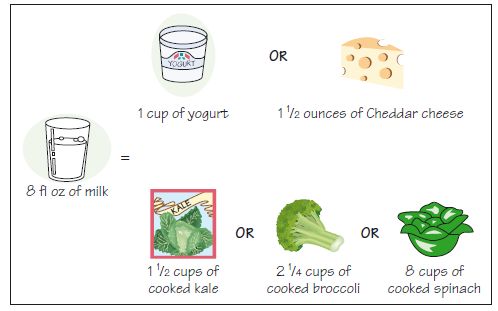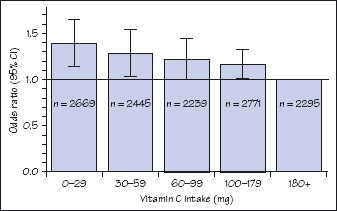13
Diet and periodontal diseases
Figure 13.1 Amounts of milk and other food sources providing 300 mg of calcium (Weaver et al., 1999).

Figure 13.2 Odds ratio for periodontal disease (mean clinical attachment loss >1.5 mm) by level of dietary vitamin C intake after adjusting for age decade, gender, tobacco use, and gingival bleeding in the National Health and Nutrition Examination Survey (NHANES) III (Nishida et al., 2000b). Weights provided in NHANES III data were used, and tobacco use, age decade, gender and gingival bleeding were adjusted for using multiple logistic regression. Dietary vitamin C intake was divided into five categories, and odds ratios are presented using the highest intake group as a reference. CI, confidence interval.

Figure 13.3 Health risks of too much calcium.

Figure 13.4 Government recommended intake of vitamin C.

Table 13.1 Association of periodontal disease (mean clinical attachment loss of >1.5mm) with calcium intake in males and females of different ages after adjusting for tobacco use status and gingival bleeding in the National Health and Nutrition Examination Survey (NHANES) III (Nishida et al., 2000a).
| Age Range | Male | Female |
| 20–30 years Odds ratio* 95% CI P value N |
1.84 1.36–2.48 <0.001 2727 |
1.99 1.34–2.97 <0.001 3348 |
| 40–59 years Odds ratio* 95% CI P value N |
1.90 1.41–2.55 <0.001 1675 |
1.31 0.85–2.03 0.2401 1863 |
| 60+ years Odds ratio* 95% CI P value N |
1.11 0.71–1.71 0.6582 1422 |
1.13 0.86–1.48 0.4037 1384 |
CI, confidence interval.
* Computer software and weights provided in NHANES III data were used, and odds ratios were adjusted for tobacco use (ategorized as ‘never’, ‘former’ and ‘current’) and gingival bleeding in multiple logistic regression.
Table 13.2 Recommended adequate intake for dietary calcium for males and females combined (Standing Committee on the Scientific Evaluation of Dietary Reference Intakes, 1997).
| age | Calcium (mg/day) | Pregnancy and lac/> |
Stay updated, free dental videos. Join our Telegram channel

VIDEdental - Online dental courses


